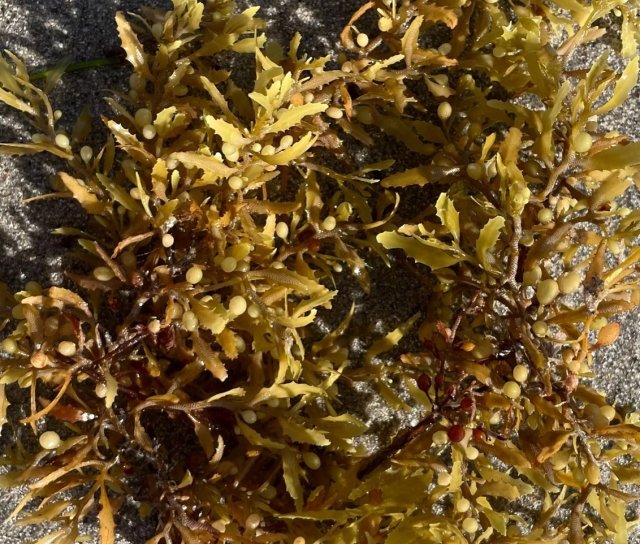Basic Information on Sargassum
Related information in Spanish
Sargassum is a group of brown algae that provides food, refuge, and breeding ground for many marine animals, such as turtles, crabs, shrimp, fish, and seabirds. Sargassum species are widely distributed across tropical and temperate oceans, in shallow waters and coral reefs, as well as the open ocean. While some species of Sargassum are attached to the bottom of the seafloor, others spend their entire lives free-floating in the ocean. The types most commonly seen around the Atlantic, Caribbean, and Gulf of America are the free-floating variety, and they form aggregations or floating mats of mixed species, which sink to the seafloor once they die.
On this page:
Biology of Sargassum
Two species of this algae, Sargassum natans and Sargassum fluitans, are found in the Sargasso Sea and the Great Atlantic Sargassum Belt (GASB). Sargassum natans has long-stalked and narrow leaves, while Sargassum fluitans has short-stalked and broad leaves. Both species rely on air filled pods to float -those in Sargassum natans are tipped with a spike while those in Sargassum fluitans are not. These two free-floating species are responsible for Sargassum inundation events (SIEs) along the coasts of the Atlantic, Caribbean, and Gulf of America. However, the abundance of different genetic variants of these two species differs within each of these geographic locations. Sargassum natans VIII Parr is the dominant form in the GASB, while Sargassum natans I Parr is the dominant form in the Sargasso Sea.

Sargassum aggregations are made up of a few species that cover large areas of the ocean’s surface and are washed onto shores by wind and ocean currents. After Sargassum aggregations inundate coastal areas and die, they decompose and are often referred to as “golden” or “brown tides” due to their color and the discoloration of the water caused by leaching of dissolved organic matter.
Ecological Importance of Sargassum
Sargassum mats serve as unique floating ecosystems for an array of diverse aquatic species, including migratory organisms (crabs, shrimp, sea turtles) and commercial fish (e.g., tuna and marlin). Sargassum species in the Southeast U.S., Gulf of America, and the U.S. Caribbean have been designated as Essential Fish Habitat (EFH) for several open sea fish species and as Critical Habitat for loggerhead sea turtles under the Endangered Species Act in two distinct areas in the U.S. South Atlantic and Gulf of America.
Ideal Growing Conditions for Sargassum
Ideal Sargassum growing conditions are high sunlight (minimum of 200-300 µmol/m2·s), typical ocean salinity (36-42 PSU), warm ocean temperatures (18-30°C or 64.4-86°F), and elevated nutrient concentrations, specifically when the ratio of nitrogen to phosphorus is less than 30-35.
Sargassum, like other algae, relies on sunlight and produces oxygen during periods of photosynthesis and can consume a large amount of oxygen during respiration. Decomposition of Sargassum consumes oxygen from the water column, and as a result “golden” or “brown tides” are associated with low (hypoxic) or no oxygen (anoxic) conditions.
References
- Chávez, V., Uribe-Martínez, A., Cuevas, E., Rodríguez-Martínez, R. E., van Tussenbroek, B. I., Francisco, V., Estévez, M., Celis, L. B., Monroy-Velázquez, L. V., & Leal-Bautista, R. (2020). Massive influx of pelagic Sargassum spp. on the coasts of the Mexican Caribbean 2014–2020: Challenges and opportunities. Water, 12, 2908.
- Coston-Clements, L., Settle, L. R., Hoss, D. E., & Cross, F. A. (1991). Utilization of the Sargassum habitat by marine invertebrates and vertebrates, a review. US Department of Commerce, National Oceanic and Atmospheric Administration.
- Doyle, E., & Franks, J. S. (2015). Sargassum [Fact Sheet]. Gulf and Caribbean Fisheries Institute.
- Endangered and Threatened Species: Critical Habitat for the Northwest Atlantic Ocean Loggerhead Sea Turtle District Population Segment (DPS) and Determination Regarding Critical Habitat for the North Pacific Ocean Loggerhead DPS, 79 Fed. Reg. 39856 (July 10, 2014) (to be codified at 50 CFR 226).
- Hanisak, M. D., & Samuel, M. A. (1987). Growth rates in culture of several species of Sargassum from Florida, USA. Hydrobiologia, 151-152(1), 399-404.
- Laffoley, D. d'A., Roe, H. S. J., Angel, M. V., Ardron, J., Bates, N. R., Boyd, I. L., Brooke, S., Buck, K. N., Carlson, C. A., Causey, B., Conte, M. H., Christiansen, S., Cleary, J., Donnelly, J., Earle, S. A., Edwards, R., Gjerde, K. M., Giovannoni, S. J., Gulick, S., Gollock, M., Hallett, J., Halpin, P., Hanel, R., Hemphill, A., Johnson, R. J., Knap, A. H., Lomas, M. W., Mckenna, S. A., Miller, M. J., Miller, P. I., Ming, F. W., Moffitt, R., Nelson, N. B., Parson, L., Peters, A. J., Pitt, J., Rouja, P., Roberts, J., Roberts, J., Seigel, D. A., Siuda, A. N. S., Steinberg, D. K., Stevenson, A., Sumaila, V. R., Swartz, W., Thorrold, S., Trott, T. M., & Vats, V. (2011). The protection and management of the Sargasso Sea: The golden floating rainforest of the Atlantic Ocean. Summary Science and Supporting Evidence Case. Sargasso Sea Alliance, 44 pp.
- Johns, E. M., Lumpkin, R., Putman, N. F., Smith, R. H., Muller-Karger, F. E., Rueda-Roa, D. T., Hu, C., Wang, M., Brooks, M. T., & Gramer, L. J. (2020). The establishment of a pelagic Sargassum population in the tropical Atlantic: Biological consequences of a basin-scale long distance dispersal event. Progress in Oceanography, 182, 102269,
- Magnuson-Stevens Fishery Conservation and Management Act et seq., 16 U.S.C. §§1801-1891d (1976).
- National Oceanographic and Atmospheric Administration, Fisheries Southeast Regional Office (NOAA, SERO). (2023). Frequently asked questions regarding annual inundations of Sargassum in the Southeastern United States [Q & A]. National Oceanographic and Atmospheric Administration.
- Schell, J. M., Goodwin, D. S., & Siuda, A. N. S. (2015). Recent Sargassum inundation events in the Caribbean: Shipboard observations reveal dominance of a previously rare form. Oceanography, 28(3), 8–10.
- Wang, M., Hu, C., Barnes, B. B., Mitchum, G., Lapointe, B., & Montoya, J. P. (2019). The great Atlantic Sargassum belt. Science, 365, 83-87.
